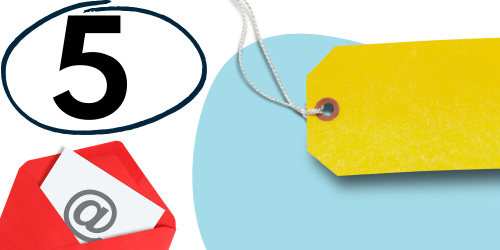Conversational Marketing: How to Scale the Conversation
 Stephanie Shreve
·
5 minute read
Stephanie Shreve
·
5 minute read
It’s 2023. It’s time to stop pretending your target audience can’t sniff out cookie-cutter, inauthentic attempts at “engagement.”
Canned customer engagement strategies that lack meaningful or authentic interactions can work against your company’s efforts to build brand recognition, develop customer loyalty, and cultivate genuine relationships with your target audience, customer base, vendors, and partners.
Instead, marketers must focus their efforts in 2023 on building trust and nurturing relationships the old-fashioned way: by pounding the pavement to identify pain points and working tirelessly to provide solutions. But how can we reliably identify these pain points quickly and cost-effectively?
A conversation, of course!
And how can we generate valuable, actionable conversations with our target audience at scale?
Conversational marketing!
Conversational marketing is a specialized tactic that allows marketers to engage in two-way conversations with customers to provide instant, relevant feedback. Marketers can then leverage this feedback into high-impact campaigns that resonate with your target audience to build connections that become conversions.
Who benefits from conversational marketing?
Three groups benefit from conversational marketing the most: your customers, your sales teams, and your service squad.
Customers
Conversational marketing is (almost) all about your customers.
Advances in technology have driven expectations for engagement and immediacy to never-before-seen heights. Customers have become accustomed to “now” and don’t want to wait days (or even hours, really) to get answers to their most pressing questions. Online messaging allows marketers to interact with prospective customers 24/7 and engage them when they are the ripest for conversion.
Sales
Sales teams also benefit from conversational marketing’s ability to provide rich customer qualification data.
By asking the right questions and constantly refining those questions using feedback, customers can increasingly be routed to the ideal resource or salesperson to move them closer to converting. It also helps salespeople refrain from investing time and energy into painfully familiar time-sinks, like customer form submissions from individuals looking for a user manual rather than more information about a potential purchase.
By streamlining customer communication, customers' needs can be determined and resolved quickly and efficiently. A sales representative can focus on those who desire to learn more and make a purchase.
Service Department
Marketers should be sure to consult service teams before launching conversational marketing programs. Service specialists are generally keenly aware of the most frequently asked questions posed by your customers and target audience and where to best direct customers.
They also tend to be eager to help offload simple, repetitive, and easily-answered questions, freeing them up to focus their time and energies on more complex, higher-value interactions.
How is conversational marketing implemented?
Currently, conversational marketing is still a hands-on task.
Marketers can create their own custom script programs within chatbots to lead visitors through a predetermined path of questions and answers that enhances brand engagement and provides invaluable data for your sales team.
Companies can also offer 24/7 live agent services for next-level engagement with an undeniably human touch. Companies should consider implementing chat conversations along each aspect of the customer journey.
The Future of Conversational Marketing
Artificial intelligence (AI) is quickly becoming mainstream and rapidly advancing marketers' capability to generate valuable online conversations.
OpenAI recently launched a beta version of its newest service, ChatGPT. ChatGPT uses conversations to ask follow-up questions and challenge or reject incorrect premises. Google has a similar experimental project called LaMDA (Language Model for Dialogue Applications), which will respond to inquiries in a realistic, lifelike manner.
As these tools reach new levels of accuracy, develop strategies to combat bias and objectionable content, and create safeguards for individual privacy, they will change the face of online conversations.
Common Conversational ChatBots
From the first interaction to the moment of conversion, conversational marketing brings the relationship with the customer to the forefront of each marketing effort. Let’s take a look at how some of the most common styles of ChatBots enhance your conversational marketing, build your brand, and drive sales.
Welcome Chats: These chats greet visitors when they first arrive on the site. They help set the tone for how your visitors interact, engage, and identify your brand. A fine-tuned welcome chat can keep visitors on the hook and encourage them to dive deeper into your site. The right Welcome Chat also keeps your brand top-of-mind once your interaction has ended.
Activity-Based Chats: These chats only activate after a specific amount of time has passed or a number of site pages have been browsed. These strategic chats can be used to drive actions like sign-ups and sales during critical phases of the customer journey.
Behavior-Based Chats: These chats are fine-tuned to engage and capture site visitors that have self-selected into a particular behavioral category, like returning visitors, customers with abandoned carts, and recent email or reward program subscribers.
Pro Tip: Social media channels are also a valuable primary source for customer interactions and engagement. Don't forget to mine your followers for conversational gold!
How should chatbot interactions be optimized?
There are three key elements to optimizing a chatbot interaction - the script, the format (live person or bot), and the data analysis.
The Script
One of the most pivotal (and resource-intensive) aspects of launching a conversational marketing campaign is carefully researching, ideating, and writing ChatBot's script.
Arming your ChatBot with a name and unique avatar can also go a long way toward building a rapport with your customers and enticing them to engage with your brand on a deeper, more emotional level.
Marketers should keep their company's unique brand tone front-of-mind while writing ChatBot scripts. If the brand is fun and playful, the chat should reflect that persona.
Marketers should also ensure their script and program have anticipated and covered potential dead-ends. Be sure to ask yourself questions like:
- Is there a way to back out of the script if the customer wants to start over?
- What action should the customer take if the chat doesn't have the information to answer the question?
- What type of interactions will this particular ChatBot face most often?
As with all copywriting exercises, marketers should put themselves in the position of the customer and consider any type of interaction that could occur.
This does not mean that the goal is length. Chatbot scripts don't have to be long interactions. Short one or two-question surveys can add an interactive element to a website and be used to gather visitor insights. Scripts can be used to gather customer satisfaction or feedback on website content. Short, simple questions can serve as very valuable data collection points.
Pro Tip: If you're struggling to write a script for your ChatBot, consider using these script thought-starters for inspiration:
- Website FAQs
- Product selectors
- Gift guides
- Local store information
- Warranty and service details
- Contact us fields
The Format
There are two ChatBot formats: live representative chats and automated chats.
Making it easy for site visitors to tell if they're chatting with someone face-to-face (or rather, screen-to-screen) or an automated bot is essential for supporting positive, productive user experiences.
Most negative experiences with ChatBots can be traced back to misguided expectations created by visitors who believe they're speaking with a live representative. By making it easy for visitors to differentiate between automatic and staffed ChatBots, you can encourage visitors to adjust their behavior to generate optimum outcomes. We dive more into this expectation of AI vs live interactions in our blog here.
The Data Analysis
And the highlight of conversational marketing is the wealth of data it provides into customers' needs and requests. As with any initiative, marketers should establish clear and measurable success metrics for the chat program.
Depending on the needs of the business, sample success criteria could include metrics like:
- Number of chat interactions
- Percentage of visitors who interact with the chat
- Drop-off conversations
- Chats that result in customer data collection (sales leads)
Ready to get started?
Authentic, meaningful customer engagement will separate scaling companies from their stagnant competitors in 2023.
Early adopters of conversational marketing will earn a leg-up that allows them to make invaluable inroads with their target audience that position them to run away with market share and sales - will you be one of them?

.png)
